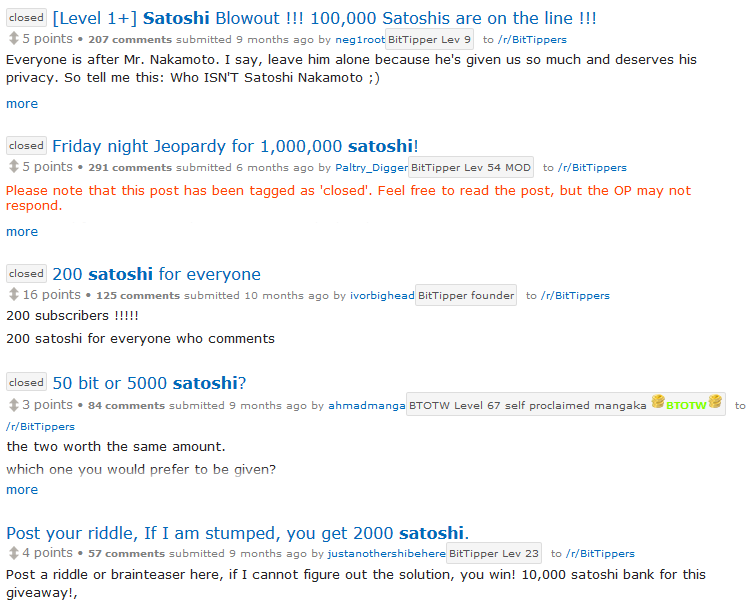Satoshi (unit)

The satoshi is currently the smallest unit of the bitcoin currency recorded on the block chain.[1] It is a one hundred millionth of a single bitcoin (0.00000001 BTC).[1] The unit has been named in collective homage to the original creator of Bitcoin, Satoshi Nakamoto.[2]
All amounts in the block chain are denominated in satoshi before being converted for display.[3] The source code also uses satoshi when specifying an amount of bitcoin.[4] When displaying an extremely fine fraction of a bitcoin, as in a contemporary faucet, the amount is displayed in satoshi for readability.[5]
As of July 2017, 1 US cent is worth approximately 430 satoshi.
History
The value of a bitcoin in satoshi was decided by Satoshi Nakamoto to be 100 million no later than November 2008.[4]
On November 15, 2010, ribuck proposed that the one hundredth of a bitcoin (0.01 BTC) be called a Satoshi.[6] Four months later he instead suggested that the one hundred millionth unit be called an austrian or a satoshi.[7] The name satoshi caught on, and was widely adopted thereafter.[2]
Usage
Plural
Traditionally, the plural form has been simply satoshi,[8] but the term satoshis is also popular. If the plural form were to follow the rules of Japanese grammar, it may be pronounced as satoshi,[9] or satoshisa.[9]
Symbol
Satoshi is sometimes abbreviated to sat or s, although no symbol has been widely adopted.
There are various proposed symbols:
| Symbol | Explanation |
|---|---|
| 里 | In Japanese names, this character can (rarely) be read "satoshi". It is an uncommon Chinese/Japanese character on its own, and an infrequent radical (kangxi #166). It can be seen as a radical in the common kanji 理 and 量, used in meaningful words like: 理想 (ideals), 理論 (theory), 理性 (reason), 理科 (science), and 量 (quantity). "Satoshi" is a rare reading; more commonly it is read as "ri" or "sato". |
| シ | A Japanese katakana representing the syllable "shi". Note that this character is extremely common in Japanese, so it could cause confusion. Also, it can mean "death" in Japanese and Chinese. |
| ㋛ | As above, but circled to distinguish it from the katakana. |
| し | As above, but this is the hiragana instead of the katakana. This is even more common than シ in Japanese writing, however. |
| サ | A Japanese katakana representing the syllable "sa". Maybe it looks more reminiscent of a currency symbol than others. Note that this character is extremely common in Japanese, so it could cause confusion. |
References
- ↑ 1.0 1.1 What is a 'Satoshi'? - Bitcoin Stack Exchange
- ↑ 2.0 2.1 BitcoinTalk thread 407442. How did “satoshi” become the name of the base unit? 9 January 2014. Post 4415850.
- ↑ BitcoinTalk thread 819656. Why 1BTC should equal 10^8 satoshi ? 11 October 2014.
- ↑ 4.0 4.1 BitcoinTalk thread 382374. Bitcoin source from November 2008. 23 December 2013.
- ↑ Barnes, Samuel (9 April 2014). "Do These "Free Bitcoin" Sites Work?". CryptoCoinsNews. https://www.cryptocoinsnews.com/do-free-bitcoin-sites-work/. Retrieved 19 August 2015.
- ↑ BitcoinTalk thread 369. Official Bitcoin Unicode Character? 14 July 2010. Post 22160.
- ↑ BitcoinTalk thread 3311. More divisibility required - move the decimal point 10 February 2011. Post 46648.
- ↑ Bitcoin Wiki revision by theymos
- ↑ 9.0 9.1 BitcoinTalk thread 289475. satoshii 9 September 2013. Post 3112861.